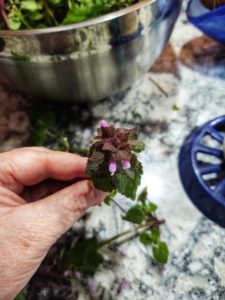Uncovering the Healing Power of Purple Dead Nettle: Your Secret Weapon Against Seasonal Allergies

Closeup of Purple Dead Nettle
Spring is in full swing, and for many of us – especially me – that means dealing with the dreaded seasonal allergies. Sneezing, itchy eyes, and a runny nose can really put a damper on enjoying the outdoors. But fear not, nature has a way of providing relief, and one such remedy is the often-overlooked purple dead nettle.
You might have seen this vibrant plant with its striking purple leaves and delicate flowers growing in your backyard or along hiking trails. What you may not know is that purple dead nettle (Lamium purpureum) has a long history of medicinal use and is known for its impressive health benefits, particularly in combating seasonal allergies.
A Natural Antihistamine
Purple dead nettle contains compounds that act as natural antihistamines, which can help alleviate the symptoms of seasonal allergies such as sneezing, itching, and congestion. Histamines are chemicals released by the immune system in response to allergens, triggering the allergic response. By inhibiting histamine release, purple dead nettle can provide much-needed relief without the side effects commonly associated with over-the-counter antihistamines.
Anti-Inflammatory Properties
In addition to its antihistamine effects, purple dead nettle also boasts anti-inflammatory properties. Allergies often lead to inflammation in the respiratory tract, causing discomfort and difficulty breathing. The anti-inflammatory compounds in purple dead nettle can help reduce this inflammation, making breathing easier and relieving symptoms like coughing and wheezing.
Rich in Nutrients
Purple dead nettle isn’t just a one-trick pony when it comes to health benefits. It’s also packed with nutrients that support overall well-being. The plant is a good source of vitamins A and C, both of which are important for a healthy immune system. Vitamin A plays a role in maintaining mucous membranes, including those in the respiratory tract, while vitamin C is a powerful antioxidant that helps combat oxidative stress in the body.
How to Use Purple Dead Nettle
Now that you’re convinced of its benefits, you might be wondering how to incorporate purple dead nettle into your wellness routine. Here are a few ideas:
- Tea: Steep dried purple dead nettle leaves in hot water for a soothing tea that can be enjoyed throughout the day.
- Salads: Add fresh purple dead nettle leaves to salads for a nutritious boost. The leaves have a slightly tangy flavor that pairs well with other greens.
- Tinctures: For a more concentrated dose, consider making a tincture using fresh or dried purple dead nettle. This can be taken orally or added to drinks.
- Steam Inhalation: Boil fresh purple dead nettle leaves in water and inhale the steam to help clear nasal passages and ease respiratory symptoms.
Final Thoughts
While purple dead nettle may not be as well-known as some other herbal remedies, its medicinal benefits are certainly worth exploring, especially for those dealing with seasonal allergies. As with any natural remedy, it’s essential to consult with a healthcare professional, especially if you have underlying health conditions or are taking medications.
So next time you’re out for a walk and come across a patch of purple dead nettle, take a moment to appreciate nature’s pharmacy and consider harnessing its healing power for your well-being.
References:
- Barros, Lillian et al. “Characterization of phenolic compounds in wild medicinal flowers from Portugal by HPLC-DAD-ESI/MS and evaluation of antifungal properties.” Journal of Pharmaceutical and Biomedical Analysis, vol. 41, no. 1, 2006, pp. 274-282.
- Jarić, Snežana et al. “An ethnobotanical survey of traditionally used plants on Suva planina mountain (south-eastern Serbia).” Journal of Ethnopharmacology, vol. 175, 2015, pp. 93-108.
- Šavikin, Katarina et al. “Ethnobotanical study on traditional use of medicinal plants in South-Western Serbia, Zlatibor district.” Journal of Ethnopharmacology, vol. 146, no. 3, 2013, pp. 803-810.
By Kathy McCabe, with support from: OpenAI. (2024). ChatGPT (3.5) [Large language model]. https://chat.openai.com

Kathy is an herbalist/naturopathic practitioner who is constantly researching to expand her knowledge. She came to herbalism after her migraine medicine was suddenly removed from the market and she had to find something new. After discovering the magic of herbs she’s never looked back. She is accredited by the International Practitioners of Holistic Medicine (IPHM) and is an Associate Member of the American Herbalist Guild.